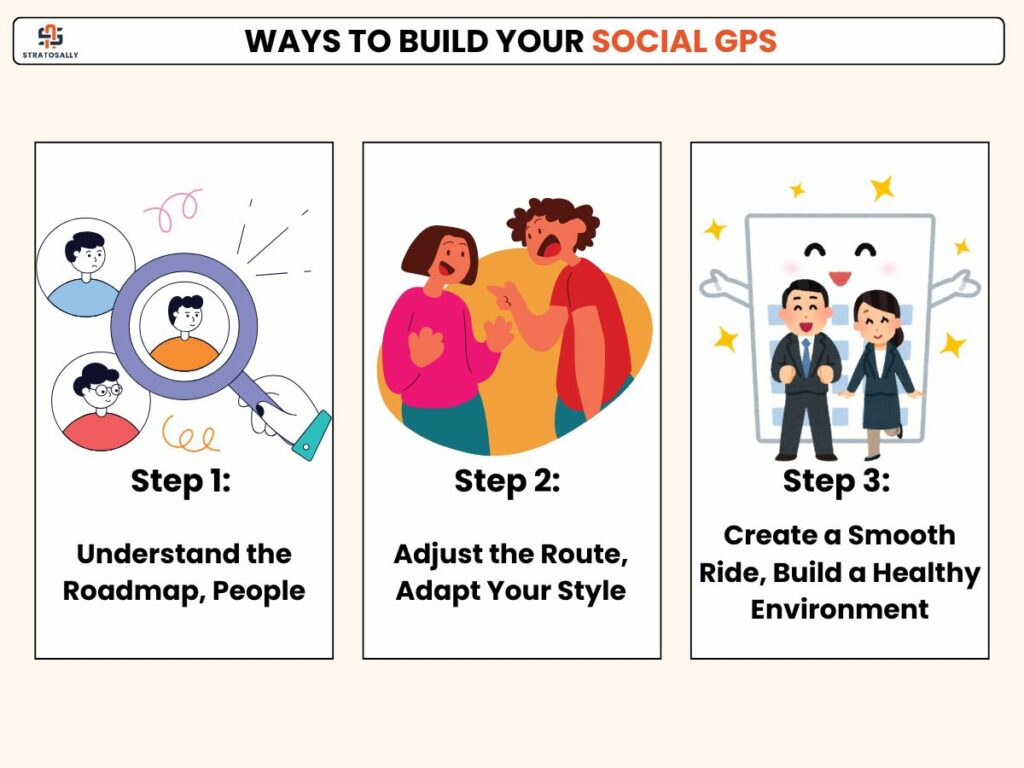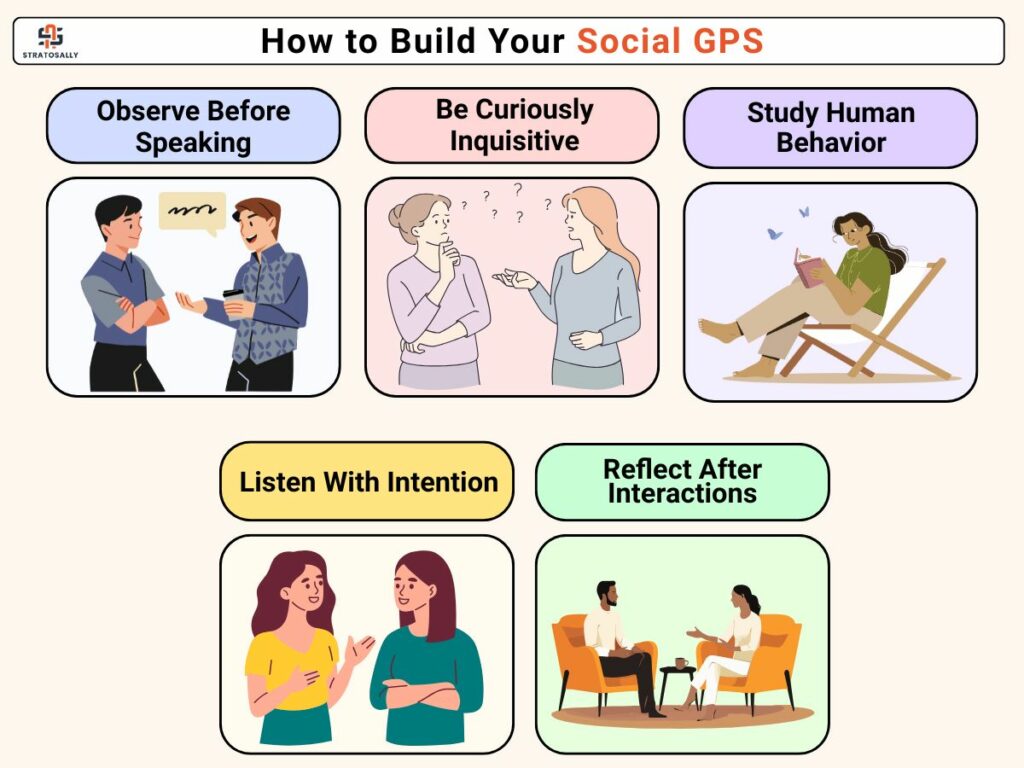“How did he get along with everyone?”
A question we have all asked ourselves, especially when we see someone float through social interactions like they were born with a built-in Google Maps for people.
Well, guess what? That is not just charisma or luck. That’s Social GPS, the subtle, strategic, and often underappreciated soft skill of reading the room, adjusting your route, and arriving at harmony, even when the personalities are as different as sun and moon.
Let’s decode this superpower and learn how you can develop your own internal navigation system for smoother, smarter, and more successful interactions.
What is Social GPS?
Think of Social GPS as your inner navigator, which guides you through the traffic of personalities, emotional signals, and communication styles. Just like a GPS reroutes you when you take the wrong turn, Social GPS helps you pivot, pause, or proceed depending on who you are interacting with and how they respond.
It’s not about being fake or manipulative, it’s about being aware, intentional, and adaptive.
Imagine this:
You are a potato. Yes, a potato.
What’s amazing about a potato? It blends into any dish. From burger to fries, it just fits. That is the magic of people with Social GPS, they blend, adapt, and vibe without losing themselves.

Step 1: Understand the Roadmap, People
Before you start rerouting, you need to read the map. And that map is human behavior.
Personality Types
Use frameworks like the Myers-Briggs Type Indicator (MBTI), DISC, or the Big Five. While not absolute truths, they help you get a basic sense of how people process emotions, make decisions, and engage with the world.
For example:
- Introverts may need more one-on-one time.
- Feelers might value empathy over logic.
- Judgers might prefer structure and clarity.
- But don’t box people in, observe, listen, and refine your understanding.
Observe & Listen
People will tell you who they are, you just need to watch and listen. How do they speak? Do they like details or summaries? Are they energized in crowds or quiet settings? Is their tone warm or firm?
Build Empathy
You can’t navigate social situations without empathy. Ask yourself:
- What might they be feeling right now?
- What’s motivating their behavior?
- How can I make this interaction easier for both of us?
Empathy is your compass, it keeps you centered and humane.
Step 2: Adjust the Route, Adapt Your Style
You don’t talk to your boss the same way you talk to your childhood best friend (hopefully). That’s Social GPS in action.
Match Their Communication Style
Talking to a fast-paced decision-maker? Be brief and results-focused.
Speaking to a thoughtful, cautious peer? Take time to explain, listen, and avoid pressure.
You don’t need to become them. You just need to shift gears.
Assign Smartly
If you’re in a leadership or team environment, tailor responsibilities based on personalities:
- Give creative freedom to innovators.
- Offer structure to planners.
- Let social butterflies handle client interactions.
People shine when they’re in their zone. Your job is to help them find it.
Social GPS helps you avoid head-on collisions. Instead of reacting, observe the situation. Maybe they’re not being difficult, they’re just feeling unheard or overwhelmed. De-escalation starts with understanding.
Step 3: Create a Smooth Ride, Build a Healthy Environment
Social GPS is not just about adjusting to others, it’s about creating an environment where everyone feels safe to be themselves.
Encourage Open Communication
Let people say what they need to, without judgment. When everyone feels heard, people drop their guards, and their egos.
Embrace All Personality Types
Don’t favor extroverts just because they are vocal. Don’t assume introverts are disengaged. Respect each person’s style, and find ways to include their voice.
Leverage Diversity
Diverse personalities bring unique problem-solving styles. A team that includes a visionary, a realist, a skeptic, and a cheerleader? That’s gold, if managed well.
Examples in Real Life
Let’s bring this to life with some real-world navigation:
In the Workplace
A manager notices one employee loves public recognition, while another prefers a quiet “well done.” She tailors her feedback style to suit both. That’s Social GPS.
At Social Gatherings
At a wedding, you’re chatting with a group of engineers and a group of artists. You shift from tech banter to creative flair, without losing your essence. That’s Social GPS.
In Relationships
Your partner prefers texting over calls. You adapt by sending thoughtful messages instead of long voice notes. That’s Social GPS.
Why It Matters (Especially in a Hybrid World)
In today’s hybrid workspaces and increasingly global environments, adaptability is not optional, it’s vital. You’re not just talking across time zones but across mindsets, cultures, and value systems.
According to a 2023 report by McKinsey, teams with high emotional intelligence and adaptability showed 25% higher productivity and 40% lower interpersonal conflict.
Social GPS isn’t fluff. It’s a strategy.
How to Build Your Social GPS

- Observe more, talk less (at least at first).
- Ask questions like a curious traveler.
- Read books on emotional intelligence and behavior psychology.
- Practice active listening in low-stakes situations.
- Debrief after interactions, what went well, what felt off?
The goal isn’t perfection. It’s awareness + adjustment.
Final Thoughts: Become the Potato
Whether you’re in a meeting or conference room, or at a family dinner with wildly different personalities, your ability to adapt, blend, and still be you is your greatest strength.
Social GPS is not about changing who you are. It’s about being more of who you are, while understanding others better.
And hey, next time someone says, “Wow, you really connect with people easily!”
Just smile and whisper to yourself:
“That’s the GPS talking.”
This isn’t the end. It’s the awkward ‘please follow us’ part. LinkedIn and Instagram. You know what to do.






